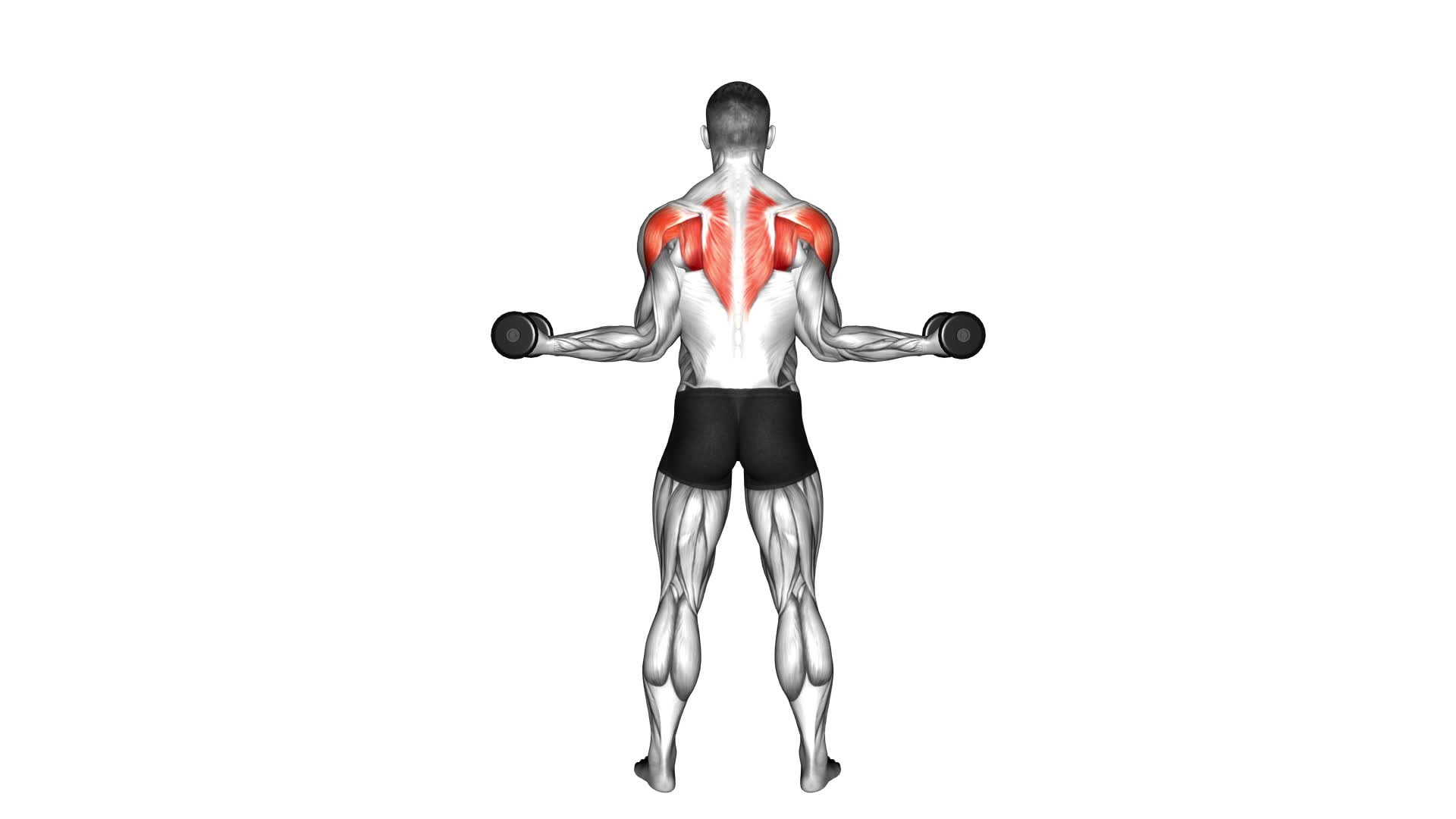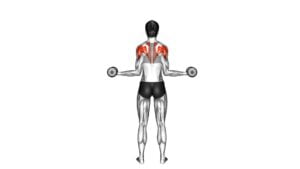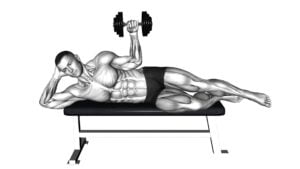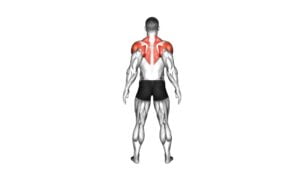Dumbbell Standing Scapular External Rotation (male) – Video Exercise Guide & Tips

Get ready to strengthen your scapular muscles with the dumbbell standing scapular external rotation exercise! In this video exercise guide, you'll learn the proper form and technique to maximize the benefits of this exercise.
Watch This Exercise Video
Discover how to choose the right weight and avoid common mistakes for optimal results. Plus, explore variations and progressions to challenge yourself even further.
Grab a dumbbell and get ready to elevate your workout routine with this effective exercise.
Key Takeaways
- Dumbbell Standing Scapular External Rotation improves shoulder stability and enhances overall shoulder function.
- It targets the muscles responsible for stabilizing the shoulder blades, reducing the risk of shoulder-related issues and injuries.
- This exercise builds strength in the shoulder muscles and improves scapular stability.
- Proper form and technique, as well as choosing the right weight, are crucial for maximizing the benefits and preventing common mistakes.
Benefits of Dumbbell Standing Scapular External Rotation
You can experience several benefits from performing dumbbell standing scapular external rotation.
This exercise is great for improving shoulder stability and preventing injuries. By targeting the muscles responsible for stabilizing your shoulder blades, such as the rhomboids and the lower trapezius, you can enhance your overall shoulder function and reduce the risk of shoulder-related issues.
Improved shoulder stability is crucial for maintaining proper alignment and preventing excessive stress on the joints. By strengthening the muscles involved in scapular external rotation, you can promote better shoulder mechanics and reduce the likelihood of imbalances or compensatory movements that can lead to injury.
In addition to injury prevention, dumbbell standing scapular external rotation also helps to enhance your overall shoulder strength and range of motion. This exercise specifically targets the muscles responsible for rotating and retracting your shoulder blades, which can lead to improved posture and upper body mechanics.
To ensure you get the most out of this exercise, it's important to focus on proper form and technique. By maintaining a stable core, keeping your shoulders relaxed, and performing the movement in a controlled manner, you can maximize the benefits and minimize the risk of injury.
Proper Form and Technique for Dumbbell Standing Scapular External Rotation
To perform dumbbell standing scapular external rotation with proper form and technique, focus on maintaining a stable core and relaxed shoulders while executing the movement in a controlled manner. Proper alignment is crucial for maximizing the effectiveness of this exercise and avoiding common errors.
Start by standing tall with your feet shoulder-width apart and a slight bend in your knees. Hold a dumbbell in each hand, palms facing down, with your arms by your sides. Engage your core muscles to stabilize your spine throughout the movement.
To begin the exercise, retract your shoulder blades by squeezing them together, then externally rotate your arms away from your body. Keep your elbows slightly bent and your wrists straight. Avoid shrugging your shoulders or allowing your upper back to round.
As you externally rotate your arms, focus on feeling the muscles in your upper back and shoulders working. Slowly return to the starting position, maintaining control and keeping your core engaged.
Proper alignment is crucial to prevent compensations and potential injury. Keep your chest up, shoulders relaxed, and avoid excessive swinging or momentum. Remember to breathe throughout the movement and perform the exercise in a slow and controlled manner.
Choosing the Right Weight for Dumbbell Standing Scapular External Rotation
To choose the appropriate weight for dumbbell standing scapular external rotation, consider using a weight that challenges your muscles without compromising proper form and technique. Selecting the proper weight is crucial to avoid injury and maximize the effectiveness of the exercise.
When determining the proper weight for this exercise, it's important to start with a weight that allows you to perform the movement with control and stability. Gradually increase the weight as you become stronger and more comfortable with the exercise. Remember, it's better to start with a lighter weight and progress gradually than to use a weight that's too heavy and risk injury.
Aim for a weight that allows you to complete the desired number of repetitions with proper form and technique. If you find that you're struggling to maintain proper form, it may be an indication that the weight is too heavy for you. On the other hand, if you're able to complete the exercise with ease, it may be a sign that the weight is too light and you need to increase it to continue challenging your muscles.
Common Mistakes to Avoid During Dumbbell Standing Scapular External Rotation
Avoiding common mistakes is crucial for performing the dumbbell standing scapular external rotation exercise effectively. By being mindful of these mistakes, you can reduce the risk of shoulder injuries and maximize the benefits of this exercise. Here are some common mistakes to avoid:
- Using too much weight: It's important to start with a weight that you can comfortably control. Using too heavy of a weight can lead to improper form and strain on the shoulders.
- Shrugging the shoulders: During the exercise, make sure to keep your shoulders relaxed and avoid shrugging them up towards your ears. This can put unnecessary stress on the muscles and increase the risk of injury.
- Arching the back: Maintain a neutral spine throughout the exercise. Avoid arching your back or leaning forward, as this can compromise the effectiveness of the movement and strain the lower back.
- Relying on momentum: Focus on slow and controlled movements rather than using momentum to swing the weights. This will engage the targeted muscles more effectively and reduce the risk of injury.
- Neglecting proper scapular retraction: As you externally rotate your shoulders, make sure to retract your shoulder blades. This helps activate the correct muscles and ensures proper alignment.
Variations and Progressions for Dumbbell Standing Scapular External Rotation
For a more challenging workout, you can progress the dumbbell standing scapular external rotation exercise by incorporating variations. These variations will target different muscles and add complexity to your routine.
One variation you can try is the standing scapular external rotation with resistance bands. Instead of using dumbbells, you'll attach a resistance band to a stable object and hold the other end with your hand. This will provide a different type of resistance and engage your muscles in a slightly different way.
Another variation is the standing scapular external rotation on an unstable surface, such as a Bosu ball. This will require more stability and core strength to perform the exercise effectively.
You can also increase the weight of the dumbbells as you become stronger to continue challenging your muscles. Progressing the exercise in this way will help you build strength and improve your scapular stability.
Remember to always maintain proper form and start with a weight that's manageable for you.
Frequently Asked Questions
How Many Sets and Reps Should I Do for Dumbbell Standing Scapular External Rotation?
For the dumbbell standing scapular external rotation, the number of sets and reps you should do depends on your fitness level. Beginners may start with 2-3 sets of 10-12 reps, while advanced individuals can aim for 3-4 sets of 12-15 reps.
It's important to choose a weight that challenges you but still allows for proper form. Gradually increase the weight and intensity as you get stronger and more comfortable with the exercise.
Is This Exercise Suitable for Beginners or Is It More Advanced?
This exercise can be suitable for beginners, but it's important to start with light weights and focus on proper form.
If you have any shoulder injuries, modifications can be made to accommodate your needs.
It's always a good idea to consult with a fitness professional or physical therapist to ensure you're performing the exercise safely and effectively.
Building a strong foundation with proper technique will help you progress to more advanced variations in the future.
Can I Do Dumbbell Standing Scapular External Rotation if I Have a Shoulder Injury?
If you have a shoulder injury, it's important to prioritize your shoulder rehabilitation and avoid exercises that may aggravate the injury.
Dumbbell standing scapular external rotation can put strain on the shoulder joint, so it may not be suitable for you at this time.
Instead, consider alternative exercises recommended by your healthcare professional or physical therapist that can help strengthen and stabilize the shoulder without causing further harm.
Will This Exercise Help With Improving Posture?
Improving your posture is important for overall health and wellbeing.
One exercise that can help with this is scapular external rotation. By performing this exercise, you can strengthen the muscles in your shoulders and upper back, which can help improve your posture.
The benefits of scapular external rotation include better shoulder stability and reduced risk of injuries. So, incorporating this exercise into your routine may be beneficial for improving your posture.
Can I Substitute Dumbbells With Resistance Bands for This Exercise?
Yes, you can substitute dumbbells with resistance bands for the scapular external rotation exercise. Using resistance bands offers a different kind of resistance that can challenge your muscles in a unique way.
It can also provide a more controlled and stable movement, reducing the risk of injury.
Furthermore, resistance bands are portable and versatile, allowing you to do the exercise anywhere.
Conclusion
In conclusion, the dumbbell standing scapular external rotation is a beneficial exercise for strengthening the muscles surrounding the shoulder blade.
By maintaining proper form and technique, and selecting the appropriate weight, individuals can effectively target these muscles and improve their shoulder stability.
It's important to avoid common mistakes and progress gradually to more challenging variations for optimal results.
Incorporating this exercise into a well-rounded fitness routine can contribute to overall shoulder health and functionality.

Author
Years ago, the spark of my life’s passion ignited in my mind the moment I stepped into the local gym for the first time. The inaugural bead of perspiration, the initial endeavor, the very first surge of endorphins, and a sense of pride that washed over me post-workout marked the beginning of my deep-seated interest in strength sports, fitness, and sports nutrition. This very curiosity blossomed rapidly into a profound fascination, propelling me to earn a Master’s degree in Physical Education from the Academy of Physical Education in Krakow, followed by a Sports Manager diploma from the Jagiellonian University. My journey of growth led me to gain more specialized qualifications, such as being a certified personal trainer with a focus on sports dietetics, a lifeguard, and an instructor for wellness and corrective gymnastics. Theoretical knowledge paired seamlessly with practical experience, reinforcing my belief that the transformation of individuals under my guidance was also a reflection of my personal growth. This belief holds true even today. Each day, I strive to push the boundaries and explore new realms. These realms gently elevate me to greater heights. The unique combination of passion for my field and the continuous quest for growth fuels my drive to break new ground.







